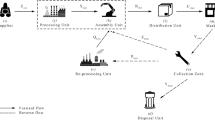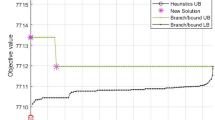Abstract
Estimating market demand for a product is essential to business growth; yet, it is exceedingly difficult. This article considers various demand patterns for a single product in a three-echelon supply chain where a single supplier, a single manufacturer and a single retailer are involved. A robust inspection process is considered at the manufacturer’s end to deliver a high-quality product to the retailer. The backorder strategy is incorporated to enhance the company’s trust and reputation among consumers. The major idea of this research is to analyze the nature of the product’s demand in three distinct situations, as well as the benefits of implementing the backorder technique. Three cases are analyzed on the basis of different demand patterns, in which the demand rate is assumed to be constant (i.e., deterministic), price-dependent and fuzzy in the first, second and third cases, respectively. To verify this model, numerical examples are tested independently with identical information for each case and owing to the complexity of the objective function; a genetic algorithm is employed to obtain the best solution. Finally, sensitivity analysis, managerial insights and conclusions, including the future directions, are provided.









Similar content being viewed by others
Data availability
Enquiries about data availability should be directed to the authors.
References
Ahmadianfar I, Heidari AA, Gandomi AH, Chu X, Chen H (2021) RUN beyond the metaphor: an efficient optimization algorithm based on Runge Kutta method. Expert Syst Appl 181:115079
Chauhan S, Vashishtha G (2023) A synergy of an evolutionary algorithm with slime Mould algorithm through series and parallel construction for improving global optimization and conventional design problem. Eng Appl Artif Intell 118:105650
Chauhan S, Vashishtha G, Kumar A, Abualigah L (2022a) Conglomeration of reptile search algorithm and differential evolution algorithm for optimal designing of FIR filter. Circuits Syst Signal Process 66:1–22
Chauhan S, Vashishtha G, Kumar A (2022b) Approximating parameters of photovoltaic models using an amended reptile search algorithm. J Ambient Intell Hum Comput 66:1–16
Clark AJ, Scarf H (1960) Optimal policies for a multi-echelon inventory problem. Manag Sci 6(4):475–490
Daryanto Y, Wee HM, Astanti RD (2019) Three-echelon supply chain model considering carbon emission and item deterioration. Transp Res E Logist Transp Rev 122:368–383
De SK, Mahata GC (2020) A production inventory supply chain model with partial backordering and disruption under triangular linguistic dense fuzzy lock set approach. Soft Comput 24(7):5053–5069
Dey BK, Sarkar B, Sarkar M, Pareek S (2019) An integrated inventory model involving discrete setup cost reduction, variable safety factor, selling price dependent demand, and investment. RAIRO Oper Res 53(1):39–57
Dey BK, Bhuniya S, Sarkar B (2021a) Involvement of controllable lead time and variable demand for a smart manufacturing system under a supply chain management. Expert Syst Appl 184:115464
Dey BK, Pareek S, Tayyab M, Sarkar B (2021b) Autonomation policy to control work-in-process inventory in a smart production system. Int J Prod Res 59(4):1258–1280
Georgescu I (2022) Inventory problems with fuzzy numbers as demands. Soft Comput 26(8):3947–3955
Ghorbani A, Jokar MRA (2016) A hybrid imperialist competitive-simulated annealing algorithm for a multisource multi-product location-routing-inventory problem. Comput Ind Eng 101:116–127
Giri BC, Masanta M (2020) Developing a closed-loop supply chain model with price and quality dependent demand and learning in production in a stochastic environment. Int J Syst Sci Oper Logist 7(2):147–163
Giri BC, Roy B, Maiti T (2017) Coordinating a three-echelon supply chain under price and quality dependent demand with sub-supply chain and RFM strategies. Appl Math Model 52:747–769
Gupta RK, Bhunia AK, Goyal SK (2009) An application of genetic algorithm in solving an inventory model with advance payment and interval valued inventory costs. Math Comput Model 49(5–6):893–905
Heidari AA, Mirjalili S, Faris H, Aljarah I, Mafarja M, Chen H (2019) Harris hawks optimization: algorithm and applications. Future Gen Comput Syst 97:849–872
Hiassat A, Diabat A, Rahwan I (2017) A genetic algorithm approach for location-inventory-routing problem with perishable products. J Manuf Syst 42:93–103
Karthick B, Uthayakumar R (2021a) An imperfect production model with energy consumption, GHG emissions and fuzzy demand under a sustainable supply chain. Int J Sustain Eng 66:1–25
Karthick B, Uthayakumar R (2021b) A single-consignor multi-consignee multi-item model with permissible payment delay, delayed shipment and variable lead time under consignment stock policy. RAIRO Oper Res 55(4):2439–2468
Kumar V, Sarkar B, Sharma AN, Mittal M (2019) New product launching with pricing, free replacement, rework, and warranty policies via genetic algorithmic approach. Int J Comput Intell Syst 12(2):519–529
La Fata CM, Passannanti G (2017) A simulated annealing-based approach for the joint optimization of production/inventory and preventive maintenance policies. Int J Adv Manuf Technol 91(9):3899–3909
Li S, Chen H, Wang M, Heidari AA, Mirjalili S (2020) Slime Mould algorithm: a new method for stochastic optimization. Future Gen Comput Syst 111:300–323
Mahapatra AS, Soni NH, Mahapatra MS, Sarkar B, Majumder S (2021) A continuous review production-inventory system with a variable preparation time in a fuzzy random environment. Mathematics 9(7):747
Maiti MK, Maiti M (2005) Inventory of damageable items with variable replenishment and unit production cost via simulated annealing method. Comput Ind Eng 49(3):432–448
Maiti MK, Maiti M (2007) Two-storage inventory model with lot-size dependent fuzzy lead-time under possibility constraints via genetic algorithm. Eur J Oper Res 179(2):352–371
Malik AI, Sarkar B (2020) Disruption management in a constrained multi-product imperfect production system. J Manuf Syst 56:227–240
Mishra P, Talati I (2019) Optimizing integrated production-inventory model for time-dependent deteriorating items using analytical and genetic algorithm approach. In: Soft computing for problem solving. Springer, Singapore, pp 535–546
Mula J, Peidro D, Poler R (2010) The effectiveness of a fuzzy mathematical programming approach for supply chain production planning with fuzzy demand. Int J Prod Econ 128(1):136–143
Patra K, Mondal SK (2015) Risk analysis in a production inventory model with fuzzy demand, variable production rate and production time dependent selling price. Opsearch 52(3):505–529
Roy TK, Maiti M (1998) Multi-objective inventory models of deteriorating items with some constraints in a fuzzy environment. Comput Oper Res 25(12):1085–1095
Sarkar B, Bhuniya S (2022) A sustainable flexible manufacturing-remanufacturing model with improved service and green investment under variable demand. Expert Syst Appl 202:117154
Sarkar B, Ganguly B, Sarkar M, Pareek S (2016) Effect of variable transportation and carbon emission in a three-echelon supply chain model. Transp Res E Logist Transp Rev 91:112–128
Sarkar B, Omair M, Choi SB (2018) A multi-objective optimization of energy, economic, and carbon emission in a production model under sustainable supply chain management. Appl Sci 8(10):1744
Sarkar B, Tayyab M, Kim N, Habib MS (2019) Optimal production delivery policies for supplier and manufacturer in a constrained closed-loop supply chain for returnable transport packaging through metaheuristic approach. Comput Ind Eng 135:987–1003
Sarkar S, Tiwari S, Wee HM, Giri BC (2020a) Channel coordination with price discount mechanism under price-sensitive market demand. Int Trans Oper Res 27(5):2509–2533
Sarkar B, Omair M, Kim N (2020b) A cooperative advertising collaboration policy in supply chain management under uncertain conditions. Appl Soft Comput 88:105948
Sarkar B, Sarkar M, Ganguly B, Cárdenas-Barrón LE (2021a) Combined effects of carbon emission and production quality improvement for fixed lifetime products in a sustainable supply chain management. Int J Prod Econ 231:107867
Sarkar B, Dey BK, Sarkar M, AlArjani A (2021b) A sustainable online-to-offline (O2O) retailing strategy for a supply chain management under controllable lead time and variable demand. Sustainability 13(4):1756
Seydanlou P, Jolai F, Tavakkoli-Moghaddam R, Fathollahi-Fard AM (2022) A multi-objective optimization framework for a sustainable closed-loop supply chain network in the olive industry: hybrid meta-heuristic algorithms. Expert Syst Appl 66:117566
Shaabani H, Kamalabadi IN (2016) An efficient population-based simulated annealing algorithm for the multi-product multi-retailer perishable inventory routing problem. Comput Ind Eng 99:189–201
Shah NH, Chaudhari U, Cárdenas-Barrón LE (2020) Integrating credit and replenishment policies for deteriorating items under quadratic demand in a three echelon supply chain. Int J Syst Sci Oper Logist 7(1):34–45
Soni HN, Suthar DN (2019) Pricing and inventory decisions for non-instantaneous deteriorating items with price and promotional effort stochastic demand. J Control Decis 6(3):191–215
Supakar P, Mahato SK (2018) Fuzzy-stochastic advance payment inventory model having no shortage and with uniform demand using ABC algorithm. Int J Appl Comput Math 4(4):107
Tayyab M, Sarkar B (2021) An interactive fuzzy programming approach for a sustainable supplier selection under textile supply chain management. Comput Ind Eng 155:107164
Vashishtha G, Chauhan S, Yadav N, Kumar A, Kumar R (2022a) A two-level adaptive chirp mode decomposition and tangent entropy in estimation of single-valued neutrosophic cross-entropy for detecting impeller defects in centrifugal pump. Appl Acoust 197:108905
Vashishtha G, Chauhan S, Kumar A, Kumar R (2022b) An ameliorated African vulture optimization algorithm to diagnose the rolling bearing defects. Meas Sci Technol 33(7):075013
Wang GG (2018) Moth search algorithm: a bio-inspired metaheuristic algorithm for global optimization problems. Memet Comput 10(2):151–164
Wang GG, Deb S, Cui Z (2019) Monarch butterfly optimization. Neural Comput Appl 31:1995–2014
Yadav R, Pareek S, Mittal M (2018) Supply chain models with imperfect quality items when end demand is sensitive to price and marketing expenditure. RAIRO Oper Res 52(3):725–742
Zadeh LA (1978) Fuzzy sets as a basis for a theory of possibility. Fuzzy Sets Syst 1(1):3–28
Funding
The authors have not disclosed any funding.
Author information
Authors and Affiliations
Contributions
BK was involved in conceptualization, methodology, software, writing—original draft. RU helped in validation, formal analysis, supervision, writing—review & editing.
Corresponding author
Ethics declarations
Conflict of interest
The authors declare that they have no conflict of interest.
Ethical approval
This article does not contain any studies with human participants performed by any of the authors.
Informed consent
It was obtained from all authors of this study.
Additional information
Publisher's Note
Springer Nature remains neutral with regard to jurisdictional claims in published maps and institutional affiliations.
Rights and permissions
Springer Nature or its licensor (e.g. a society or other partner) holds exclusive rights to this article under a publishing agreement with the author(s) or other rightsholder(s); author self-archiving of the accepted manuscript version of this article is solely governed by the terms of such publishing agreement and applicable law.
About this article
Cite this article
Karthick, B., Uthayakumar, R. An optimal strategy for forecasting demand in a three-echelon supply chain system via metaheuristic optimization. Soft Comput 27, 11431–11450 (2023). https://doi.org/10.1007/s00500-023-08290-x
Accepted:
Published:
Issue Date:
DOI: https://doi.org/10.1007/s00500-023-08290-x




